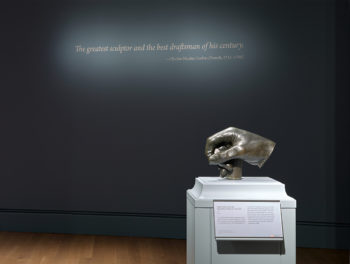
The Crucifixion (detail with Ecclesia and Synagoga), 1170s, from the Stammheim Missal, unknown illuminator, made in Hildesheim, Germany. The J. Paul Getty Museum, Ms. 64, fol. 86
Last year we invited you to join a conversation about how we can use a museum collection—made up of artworks created primarily for the wealthiest classes—to peel back layers of history and reveal a more inclusive vision of European art.
The online dialogue about the exhibition Outcasts: Prejudice and Persecution in the Medieval World inspired us to take action in two ways. First, in response to requests to provide more digital resources around the exhibition, we invited three prominent scholars to expand on three of its themes: race, anti-semitism, and gender identity. We thank these experts for their thoughtful essays, which present new insights into the experience of marginalized people in medieval Europe. We hope they will prove useful in research, teaching, and learning, and in furthering debate and dialogue on these important topics.
Second, we began to organize another exhibition, Balthazar: A Black African King in Medieval and Renaissance Art (November 19, 2019–February 16, 2020), inspired by visitors’ reactions to and questions about Outcasts. The exhibition focuses on the fascinating figure of Balthazar, a black African king depicted in scenes of the Adoration of the Magi. We look forward to inviting feedback here on The Iris as work on the exhibition progresses.
Download all three essays here, available as open-access documents under a Creative Commons license:

Download this paper as a PDF (7 pp., 614 KB).
Heng, Perceval Professor of English at the University of Texas at Austin and director of the Global Middle Ages Project (GMAP), presents ideas about race in the premodern (i.e., medieval and Renaissance) world. Her related book on this topic is titled The Invention of Race in the European Middle Ages (Cambridge, 2018).

Download this paper as a PDF (4 pp., 1.2 MB).
Bale, professor of English at University of London, Birkbeck, addresses anti-Semitism in medieval England through the lens of an arresting illumination from the Stammheim Missal in the Getty’s collection.

Download this paper as a PDF (4 pp., 1.2 MB).
Betancourt, associate professor of art history at the University of California, Irvine, explores transgender identity in the Middle Ages, with reference to narratives of transgender and gender-fluid persons across late antique and medieval literature and art.




Looking forward to Balthazar!
In contemporary Germany, the practice of black-facing persists for the role of Balthazar in nativity plays (aka Christmas pageants, or Krippenspiele), witnessed by me again in 2018. It would be an interesting topic to research if this particular “tradition” has ever been debated in Germany.